

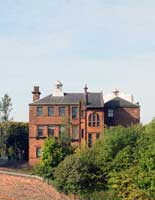
|
View of east facade from footbridge over the motor wayNow high above the more modern motor way, the school was once in a densely populated area, on a street where Mackintosh was born. One of the earlier works of Mackintosh, the Martyrsí Public School was commissioned in 1895 by the School Board of Glasgow from Honeyman and Keppie, where Mackintosh had completed his apprenticeship. The school was so named "after the Covenanters James Lawson, James Naisbit and Alexander Wood [who were] executed on this spot (known as the Howgateshead) in 1684" (internet site). The 3-story building, constructed of the red sandstone so prevalent in Glasgow, was required to serve between 900 to 1000 students. After initialy being used as a school, with various affiliations for many decades, it also was later an art center, and is now the office for Glasgow City Council's Social Work Leaving Care Services, this after being threatened with demolition in the 1970's only to be saved by the work of the Charles Rennie Mackintosh Society. | |
The east and west elevations (see west below) are similar; both have a central projecting bay, with a cantilevered eave, which contains the central stairwell, notable for the narrow decorative windows with square leaded panes. The top story of this bay has a beautiful mullioned round-arched window. All the elevations have varied fenestration, a trait which will remain in Mackintosh's works. Left and center: detail of 2nd and 3rd stories, east facade, showing central bay and gray slate roof; right: ogee ventilator with decorative finial | ||

|
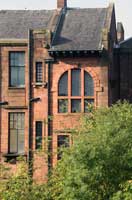
|
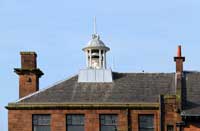
|
North elevation; 3-bay group; decorative balustradeThe center formerly had a basement door. This bay is flanked by three grouped bays on each side, the first-floor group with a partial balcony and the 2nd-floor group with bracketed lintel courses as well as cornices which link windows. The cornice has a central keystone and a rounded pediment. Decorative masonry outlines the windows. See below. | ||

|
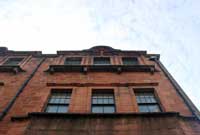
|
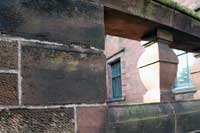 |
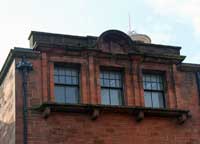
|
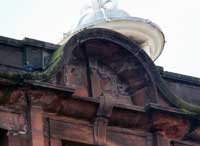
|

|
Entrance with Art Nouveau decorative lintel and flanking carved design; double doors with panels in tear-drop design |

|
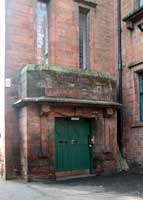
|

|
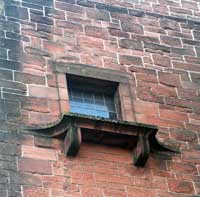
|
Window with curved and bracketed sillIn general, this early work shows a kind of restrained Art Nouveau, with fewer flourishes and elaborate curves. See Art Nouveau in Brussels for contrasts. |
View of west facade--very similar to east facade |

|

|
 Click here to return to index of art historical sites.
Click here to return to index of art historical sites.
 Click here to return to index of artists and architects.
Click here to return to index of artists and architects.
 Click here to return to chronological index.
Click here to return to chronological index.
 Click here to see the home page of Bluffton College.
Click here to see the home page of Bluffton College.

